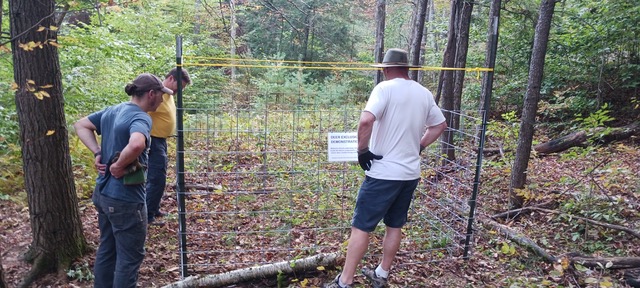Deer Exclosures Along Norwich Trails
Published Mar 1st, 2024 by Lynnwood Andrews
 A Norwich Conservation Commission deer exclosure.
A Norwich Conservation Commission deer exclosure.
Hikers along trails in Norwich may notice four deer “exclosures” recently installed by the Conservation Commission to illustrate the effects on forest health when deer are allowed to browse too heavily.
The study sites are at the Milt Frye Nature Area, Woody Adams/Gile Mountain, Brookmead, and the Montshire Museum of Science.
Exclusion is a proven method of identifying the ecological stresses on plants, animals, soils, and human health when there are too many deer. By protecting forest plots with cattle guards and fence posts, we can learn about the ways deer are threatening not only forest health and soils but wildlife populations, as well. Much remains to be learned about effective restoration methods and how long they might take.
Within the test zones, vulnerable plants won’t be eaten, trampled, or urinated on. We’ll see a microcosm of the understory as it should look, full of a wide variety of native trees, shrubs and herbaceous plants, not a stripped, compacted, acidic wasteland.
Outside the protected spots, the deer cause significant changes in soil chemistry, nutrients, and microbes.
For example, their actions allow invasive worms to multiply. The drastic reduction in total plant life, combined with selectively removing most native plants, changes the amount and varieties of soil nutrients and microbes in ways that favor invasive worms. Further, the worms themselves alter soil chemistry and composition in ways that harm many native plants, such as the sugar maple. It can take many decades to recover from these changes once deer numbers are permanently reduced.
When deer strip the understory of native plants, cascading effects ricochet throughout the ecosystem. Deer tend not to eat non-native plants such as buckthorn, bush honeysuckle, euonymus, barberry, and bittersweet. In our area, deer eat maple, oak, basswood, ash, and cherry seedlings – so much that it has become rare to see saplings above one foot high, if at all. Birch, poplar, beech, white pine, hemlock, spruce, and fir are less preferred, but nevertheless, are often browsed. The result is a significant threat to healthy forest regeneration and biodiversity. Bird populations are decreasing as a result of heavy deer browse. Birds feed nestlings exclusively on insects in spring. Insects prefer, or only grow on native plants. The very reason many non-native plants were introduced was because they are “pest-free,” meaning our insects do not eat them. When deer strip the woods of native plants, insect populations crash and birds go hungry.
Deer exclusion plots have revealed interactions among forest disturbances that threaten forest regeneration. Many forest disturbances, such as fires and falling trees, are a natural feature of forest progression. Gaps in the canopy provide light, allowing saplings to grow to maturity and understory plants to take root. With heavy deer pressure, many native plants cannot thrive. Invasives and Hay-scented fern and New York fern, two natives that deer do not eat, move in and create such dense patches that other plant seedlings are crowded out.
When deer are excluded from canopy gaps, even over decades, where ferns and other invasives have already become established, native plants do not recover. The weeds have to be removed and appropriate natives replanted by hand.
Deer exclusion studies have also verified that high deer populations increase human risks of Lyme and other tick-borne diseases. Plots with no deer have significantly fewer Lyme-infected ticks than adjacent areas have access.
The conservation commission hopes you will observe changes within the deer exclosures over the coming years and be inspired by them to support measures to reduce deer numbers and increase forest biodiversity and regeneration.
Originally published in Winter/Spring 2024 Norwich Times